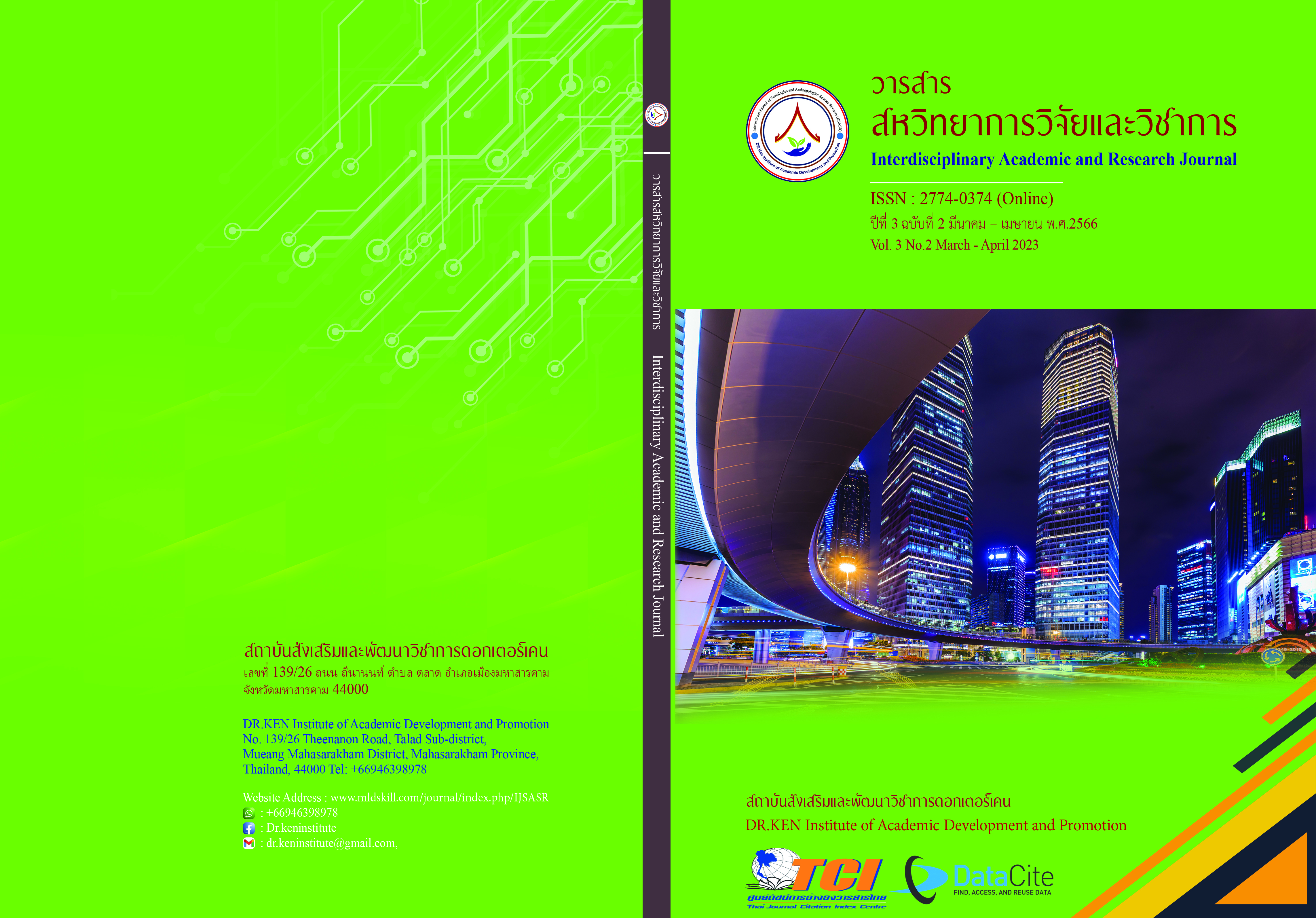The Instruction of Thai Manners Using Role-play Learning Management Integrated with Video Streaming : Ban Huana School
DOI:
https://doi.org/10.14456/iarj.2023.54Keywords:
Thai Manners;, Role-playing; , Video StreamingAbstract
Thai Manners is a social culture that everyone must adhere to as a code of conduct to adapt to society. Manners are part of the way of life as a cultural heritage. Thai Manners are a part that shows prosperity and shows orderliness, traditions, and culture. However, role-playing learning is a process that an instructor uses to help learners achieve specific learning objectives by having them role-play in simulated situations, which are close to reality and expresses according to one's feelings and thoughts. Therefore, the purpose of the current study was to investigate the effectiveness of Role Play Learning Management integrated with video streaming in Thai manner instruction of Pratomsuksa 6 students in Huana School. The samples were 22 students in the second semester of the academic year 2017, Ban Huana School Maha Sarakham Province. The instruments were learning management in the 7th unit entitled Cultures in the Thai Society of Social, Religious, and Cultural Studies course for Pratomsuksa 6 students of Huana School, a behavior observation form, and a Thai manner evaluation form. The results of the study indicate that; (1) The role-play learning management integrated with video streaming consisted of 7 components including the introduction of role-playing, character selection, observation, role-playing, discussion, conclusion, and evaluation. The manners in standing, sitting, walking, and napping of the participants were average of 2.06 fair-quality levels. (2) In terms of Thai manner evaluation, the participants’ passing and receiving items, table manners, and showing respect It has an average of 2.44 fair-quality levels. And (3) In terms of manners in conversation and word choices, the participants It has an average of 2.97 good quality levels.
References
ทิศนา แขมมณี. (2550). ศาสตร์การสอน . องค์ความรู้ เพื่อการจัดการกระบวนการเรียนรู้ที่มีประสิทธิภาพ. พิมพ์ครั้งที่ 2. กรุงเทพฯ : โรงพิมพ์แห่งจุฬาลงกรณ์มหาวิทยาลัย.
บุญส่ง นิลแก้ว (2541). วิจัยทางการศึกษา. คณะศึกษาศาสตร์มหาวิทยาลัยเชียงใหม่.
พิมพ์ชนก ฟุ้งสิริรัตน์. (2563). การตัดสินใจตลาดสตรีมมิ่งวิดีโอสตรีมมิ่งการวิเคราะห์คอนจอยท์. the 3rd BAs National Conference 2021 "Business Transformation: Social Challenges”.
รวินันท์ ฤทัยปิติเสรีวงศ. (2558). การปลูกฝังมารยาทไทยด้วยการปฏิบัติจริงของนักเรียนชั้นประถมศึกษาปีที่ 3/1 นักเรียนโรงเรียนอัสสัมชัญแผนกประถม. Bangkok: Assumption College Primary Section
วิวัฒน์ จันทร์กิ่งทอง และ รัชนี วนาพิทักษ์วงศ์ (2558). การพัฒนามารยาทไทย ด้านการยิ้ม และการไหว้ของนักเรียนชั้นมัธยมศึกษาปีที่ 3 โรงเรียนสะเดา “ขรรค์ชัยกัมพลานนท์อนุสรณ์”. การประชุมหาดใหญ่วิชาการระดับชาติ ครั้งที่ 6 26 มิถุนายน 2558 มหาวิทยาลัยหาดใหญ่, 1185-1195.
ศราวุธ ทองศรีคำ.(2561). รสนิยมของผู้ชมสตรีมมิ่ง. วารสารอาศรมวัฒนธรรมวลัยลักษณ์ มหาวิทยาลัยวลัยลักษณ์.18 (2),75-94.
อรนุช พวงทอง. (2560). การพัฒนาหนังสืออ่านเพิ่มเติม กลุ่มสาระการเรียนรู้สังคมศึกษา ศาสนาและวัฒนธรรม ชุดมารยาทไทย สำหรับนักเรียนชั้นมัธยมศึกษาปีที่ 2 . ปริญญาการศึกษามหาบัณฑิต : มหาวิทยาลัยนเรศวร
อาภรณ์ ใจเที่ยง. (2550). หลักการสอน. กรุงเทพฯ : โอเดียนสโตร์.
อิงอร รอดน้อย. (2551). พฤติกรรมการแสดงมารยาทไทยทีÉพึงประสงค์ของเด็กปฐมวัยโดยการจัด กิจกรรมการเล่านิทานประกอบการฝึกปฏิบัติจริง.วิทยานิพนธ์ปริญญาศึกษาศาสตรมหาบัณฑิต: มหาวิทยาลัยศรีนครินทรวิโรฒ
Phra Brahmagunabhorn (P.A. Payutto). (2008). Dictionary of Buddhist. 12th edition. Bangkok: Mahachulalongkorn University.
Phradhammapidok (P.A. Payutto). (1999). BuddhaDhamma. 8th edition. Bangkok: MCU Press.
Downloads
Published
How to Cite
Issue
Section
License
Copyright (c) 2023 ณัฐพล นนทสิงห์, วณิชา สาคร, ทรงศักดิ์ สองสนิท

This work is licensed under a Creative Commons Attribution-NonCommercial-NoDerivatives 4.0 International License.
Copyright on any article in the Interdisciplinary Academic and Research Journal is retained by the author(s) under the under the Creative Commons Attribution-NonCommercial-NoDerivatives 4.0 International License. Permission to use text, content, images, etc. of publication. Any user to read, download, copy, distribute, print, search, or link to the full texts of articles, crawl them for indexing, pass them as data to software, or use them for any other lawful purpose. But do not use it for commercial use or with the intent to benefit any business.
















.png)


